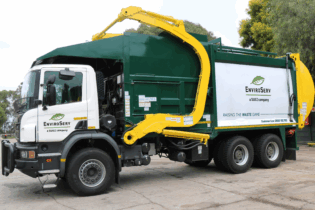With a new MD (Phillip Hechter) on board, Tosas, a leading manufacturer and distributor of value-added bituminous products in South Africa, is refocusing its efforts on research and development.
THE GROUP HAS positioned itself favourably to capitalise on a growing market demand for warm mix technology, and has established initial trials of the innovative new crumbed rubber technology (NCRT) in South Africa with great success. New leadership – new focusOn 1 July 2013, Phillip Hechter took the helm of Tosas as the company’s new MD. Hechter, previously the MD of Much Asphalt, joins Tosas with 34 years of experience in the industry. “While the company underwent changes over the past four years, which were beyond the control of the staff of Tosas, the brand remains exceptionally strong. My main objective is to reposition Tosas as a leader in the market,” says Hechter. “Together with my team, my aim is to re-establish the Tosas business as a premium binder operation in South Africa. We intend to do this through outstanding service delivery and the innovation of products into the market. That will be my key strategic focus.” Hechter will concentrate on growing the existing strong team and improving on its technical expertise to deliver on Tosas’ pledge of being a leading bitumen modifier and distributor in South Africa. “We currently have adequate resources in terms of our sprayer fleet and modified binder manufacturing capabilities to service our client base,” he says. “Going forward, Tosas will only improve on this existing service capacity, combining our strengths with focused research & development.” At the forefront of binder innovation
Tosas is well known for its supply of bitumen rubber. “We regard it as our flagship product,” says Johan Muller, technical manager of Tosas. “We imported the original technology from Arizona, US, in the 1980s and customised it for South African conditions. A big portion of the bitumen rubber technology applied in South Africa to date is based on the Tosas technology. It’s the only commercial bitumen rubber product that stood the test of time and became the South African benchmark,” Muller informs. Bitumen rubber technology is used on a wide-scale in the US, including Arizona, Texas, Florida and California. Internationally, the Rubber Pavement Association has successfully advocated for an uptake in bitumen rubber technology in road construction in China, South America and Europe. Since the early 2000’s, warm mix technology – because of its substantial safety and environmental benefits – was also gaining momentum abroad. “It took the best part of 10 years to establish confidence related to the benefits of warm mix technology in South Africa, whereas internationally it has taken off tremendously,” says Muller. In 2010, Sasol Wax approached Tosas with the introduction of a combination of warm mix technology and rubber technology that was successfully used in asphalt applications in Germany. This new patented product is NCRT.When Sasol Wax approached Tosas with the proposed NCRT, the rubber technology did not have the physical appearance of the rubber crumbs that have been used with great success over 25 years in South Africa, relative to what Tosas brought into South Africa from the US in the 1980s. “We had to adapt the physical appearance and the way that it behaved relative to what the South African market was familiar with,” Muller explains. After thorough research and development in Germany and South Africa, as well as laboratory testing and trial blends, Tosas is confident that it has developed a product suited for South African road building conditions.
All-round benefits at lower temperatures
“From a technical perspective, we know that bitumen rubber outlasts any road binder. The only drawback is that it requiresextremely high temperatures for manufacturing and application. Unfortunately, at such high temperatures it also has a short shelf life,” says Muller.
• to improve rut resistance with the elastic behaviour of the rubber crumbs
• to handle the material at lower temperatures, improving the shelf life with warm mix additives.
• elimination/reduction of fumes and aerosols from rubber asphalt during laying, especially notable with regards to smell
• energy effectiveness. Therefore, these attributes make NCRT a more sustainable, more environmentally friendly product from a Safety Health and Environment (SHE) context. “If you look at all the benefits of reduced temperatures when handling bituminous binders, an easy calculation is that for every 10oC temperature increase, the ageing rate for unmodified bitumen doubles. If you modify bitumen, you degrade the polymers, and your shelf life reduces with an increase in temperature,” says Muller. Temperatures can be reduced with conventional bitumen rubber, but the drawback is that the material can’t be pumped because it becomes too viscous and therefore becomes too difficult to handle. One of the benefits of warm mix technology is that you can reduce the viscosity of the binder, therefore allowing suppliers to reduce the temperature during manufacturing and application of road binders. “When you combine the two technologies – warm mix and rubber technology – you can handle the material at much lower temperatures but can still pump and mix it,” says Muller. There is a spin-off benefit to all players involved in the value chain when using the NCRT binder. The manufacturers of the raw material and the asphalt producers can now reduce their temperatures. They can drop the temperatures at which they need to add aggregates and mix the material at 30oC lower than conventional bitumen and modified bitumens such as bitumen rubber. Further to that, your pavement compaction temperatures are also lower, once you have produced the asphalt mix and took it to the road. According to Muller, conventional bitumen rubber can usually not be compacted below 130oC, whereas the NCRT allows a similar drop in compaction temperatures which is associated with WMA in general. By handling the material at lower temperatures, Tosas has managed to extend the shelf life of this bitumen rubber product, once manufactured, to seven days. There are major cost benefits in this shelf life extension, not only for the manufacturer, but also for the end-user. “It reduces the requirement to have an established team on-site. You could manufacture at the fixed operation depots and then transfer the material in a tanker at reduced temperatures, transport it to site, heat it up to the required temperature and apply. The establishment costs and labour costs are therefore reduced. It also reduces the client’s exposure to risk and the need for extensive quality control,” says Muller. Application to the South African market
Hechter is confident that the NCRT will be well received on the South African market. Globally, warm mix technology has been gaining substantial momentum and since 2011, with the establishment of a Warm Mix Interest Group, the technology has also taken off in South Africa. Apart from extensive laboratory testing, Tosas partnered with Much Asphalt to trial the technology at its Roodepoort plant in March 2012. In November 2012, a successful section of NCRT was placed on the Misgund section of the N1 highway, south of Johannesburg, which was part of the Gauteng Freeway Improvement Project. “We did paramount comparisons with a standard BRASO (bitumen rubber asphalt semi open) mix, which proved the substantial. In conjunction with RMS, Tosas was also involved in a sprayed seal application near Upington, in the Northern Cape, and the outcome and end results were very positive. NCRT therefore makes the road binders tougher at ambient and high road temperatures,” Muller concludes.








